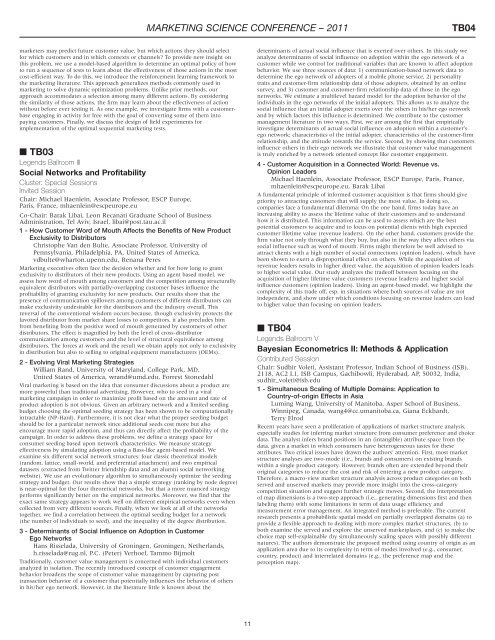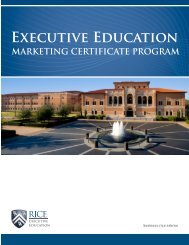2012 INFORMS Marketing Science Conference June 7
2012 INFORMS Marketing Science Conference June 7
2012 INFORMS Marketing Science Conference June 7
Create successful ePaper yourself
Turn your PDF publications into a flip-book with our unique Google optimized e-Paper software.
marketers may predict future customer value, but which actions they should select<br />
for which customers and in which contexts or channels? To provide new insight on<br />
this problem, we use a model-based algorithm to determine an optimal policy of how<br />
to run a sequence of tests to learn about the effectiveness of those actions in the most<br />
cost-efficient way. To do this, we introduce the reinforcement learning framework to<br />
the marketing literature. This approach generalizes methods commonly used in<br />
marketing to solve dynamic optimization problems. Unlike prior methods, our<br />
approach accommodates a selection among many different actions. By considering<br />
the similarity of those actions, the firm may learn about the effectiveness of action<br />
without before ever testing it. As one example, we investigate firms with a customerbase<br />
engaging in activity for free with the goal of converting some of them into<br />
paying customers. Finally, we discuss the design of field experiments for<br />
implementation of the optimal sequential marketing tests.<br />
■ TB03<br />
Legends Ballroom III<br />
Social Networks and Profitability<br />
Cluster: Special Sessions<br />
Invited Session<br />
Chair: Michael Haenlein, Associate Professor, ESCP Europe,<br />
Paris, France, mhaenlein@escpeurope.eu<br />
Co-Chair: Barak Libai, Leon Recanati Graduate School of Business<br />
Administration, Tel Aviv, Israel, libai@post.tau.ac.il<br />
1 - How Customer Word of Mouth Affects the Benefits of New Product<br />
Exclusivity to Distributors<br />
Christophe Van den Bulte, Associate Professor, University of<br />
Pennsylvania, Philadelphia, PA, United States of America,<br />
vdbulte@wharton.upenn.edu, Renana Peres<br />
<strong>Marketing</strong> executives often face the decision whether and for how long to grant<br />
exclusivity to distributors of their new products. Using an agent based model, we<br />
assess how word of mouth among customers and the competition among structurally<br />
equivalent distributors with partially-overlapping customer bases influence the<br />
profitability of granting exclusivity for new products. Our results show that the<br />
presence of communication spillovers among customers of different distributors can<br />
make exclusivity undesirable for the distributors and the industry overall. This<br />
reversal of the conventional wisdom occurs because, though exclusivity protects the<br />
favored distributor from market share losses to competitors, it also precludes him<br />
from benefiting from the positive word of mouth generated by customers of other<br />
distributors. The effect is magnified by both the level of cross-distributor<br />
communication among customers and the level of structural equivalence among<br />
distributors. The forces at work and the result we obtain apply not only to exclusivity<br />
in distribution but also to selling to original equipment manufacturers (OEMs).<br />
2 - Evolving Viral <strong>Marketing</strong> Strategies<br />
William Rand, University of Maryland, College Park, MD,<br />
United States of America, wrand@umd.edu, Forrest Stonedahl<br />
Viral marketing is based on the idea that consumer discussions about a product are<br />
more powerful than traditional advertising. However, who to seed in a viral<br />
marketing campaign in order to maximize profit based on the amount and rate of<br />
product adoption is not obvious. Given an arbitrary network and a limited seeding<br />
budget choosing the optimal seeding strategy has been shown to be computationally<br />
intractable (NP-Hard). Furthermore, it is not clear what the proper seeding budget<br />
should be for a particular network since additional seeds cost more but also<br />
encourage more rapid adoption, and thus can directly affect the profitability of the<br />
campaign. In order to address these problems, we define a strategy space for<br />
consumer seeding based upon network characteristics. We measure strategy<br />
effectiveness by simulating adoption using a Bass-like agent-based model. We<br />
examine six different social network structures: four classic theoretical models<br />
(random, lattice, small-world, and preferential attachment) and two empirical<br />
datasets (extracted from Twitter friendship data and an alumni social networking<br />
website). We use an evolutionary algorithm to simultaneously optimize the seeding<br />
strategy and budget. Our results show that a simple strategy (ranking by node degree)<br />
is near-optimal for the four theoretical networks, but that a more nuanced strategy<br />
performs significantly better on the empirical networks. Moreover, we find that the<br />
exact same strategy appears to work well on different empirical networks even when<br />
collected from very different sources. Finally, when we look at all of the networks<br />
together, we find a correlation between the optimal seeding budget for a network<br />
(the number of individuals to seed), and the inequality of the degree distribution.<br />
3 - Determinants of Social Influence on Adoption in Customer<br />
Ego Networks<br />
Hans Risselada, University of Groningen, Groningen, Netherlands,<br />
h.risselada@rug.nl, P.C. (Peter) Verhoef, Tammo Bijmolt<br />
Traditionally, customer value management is concerned with individual customers<br />
analyzed in isolation. The recently introduced concept of customer engagement<br />
behavior broadens the scope of customer value management by capturing post<br />
transaction behavior of a customer that potentially influences the behavior of others<br />
in his/her ego network. However, in the literature little is known about the<br />
MARKETING SCIENCE CONFERENCE – 2011 TB04<br />
11<br />
determinants of actual social influence that is exerted over others. In this study we<br />
analyze determinants of social influence on adoption within the ego network of a<br />
customer while we control for traditional variables that are known to affect adoption<br />
behavior. We use three sources of data: 1) communication-based network data to<br />
determine the ego network of adopters of a mobile phone service, 2) personality<br />
traits and customer-firm relationship data of those adopters, obtained by an online<br />
survey, and 3) customer and customer-firm relationship data of those in the ego<br />
networks. We estimate a multilevel hazard model for the adoption behavior of the<br />
individuals in the ego networks of the initial adopters. This allows us to analyze the<br />
social influence that an initial adopter exerts over the others in his/her ego network<br />
and by which factors this influence is determined. We contribute to the customer<br />
management literature in two ways. First, we are among the first that empirically<br />
investigate determinants of actual social influence on adoption within a customer’s<br />
ego network; characteristics of the initial adopter, characteristics of the customer-firm<br />
relationship, and the attitude towards the service. Second, by showing that customers<br />
influence others in their ego network we illustrate that customer value management<br />
is truly enriched by a network oriented concept like customer engagement.<br />
4 - Customer Acquisition in a Connected World: Revenue vs.<br />
Opinion Leaders<br />
Michael Haenlein, Associate Professor, ESCP Europe, Paris, France,<br />
mhaenlein@escpeurope.eu, Barak Libai<br />
A fundamental principle of informed customer acquisition is that firms should give<br />
priority to attracting customers that will supply the most value. In doing so,<br />
companies face a fundamental dilemma: On the one hand, firms today have an<br />
increasing ability to assess the lifetime value of their customers and to understand<br />
how it is distributed. This information can be used to assess which are the best<br />
potential customers to acquire and to focus on potential clients with high expected<br />
customer lifetime value (revenue leaders). On the other hand, customers provide the<br />
firm value not only through what they buy, but also in the way they affect others via<br />
social influence such as word of mouth. Firms might therefore be well advised to<br />
attract clients with a high number of social connections (opinion leaders), which have<br />
been shown to exert a disproportional effect on others. While the acquisition of<br />
revenue leaders results in higher direct value, the acquisition of opinion leaders leads<br />
to higher social value. Our study analyzes the tradeoff between focusing on the<br />
acquisition of higher lifetime value customers (revenue leaders) and higher social<br />
influence customers (opinion leaders). Using an agent-based model, we highlight the<br />
complexity of this trade off, esp. in situations where both sources of value are not<br />
independent, and show under which conditions focusing on revenue leaders can lead<br />
to higher value than focusing on opinion leaders.<br />
■ TB04<br />
Legends Ballroom V<br />
Bayesian Econometrics II: Methods & Application<br />
Contributed Session<br />
Chair: Sudhir Voleti, Assistant Professor, Indian School of Business (ISB),<br />
2118, AC2 L1, ISB Campus, Gachibowli, Hyderabad, AP, 50032, India,<br />
sudhir_voleti@isb.edu<br />
1 - Simultaneous Scaling of Multiple Domains: Application to<br />
Country-of-origin Effects in Asia<br />
Luming Wang, University of Manitoba, Asper School of Business,<br />
Winnipeg, Canada, wang4@cc.umanitoba.ca, Giana Eckhardt,<br />
Terry Elrod<br />
Recent years have seen a proliferation of applications of market structure analysis,<br />
especially studies for inferring market structure from consumer preference and choice<br />
data. The analyst infers brand positions in an (intangible) attribute space from the<br />
data, given a market in which consumers have heterogeneous tastes for these<br />
attributes. Two critical issues have drawn the authors’ attention. First, most market<br />
structure analyses are two-mode (i.e., brands and consumers) on existing brands<br />
within a single product category. However, brands often are extended beyond their<br />
original categories to reduce the cost and risk of entering a new product category.<br />
Therefore, a macro-view market structure analysis across product categories on both<br />
served and unserved markets may provide more insight into the cross-category<br />
competition situation and suggest further strategic moves. Second, the interpretation<br />
of map dimensions is a two-step approach (i.e., generating dimensions first and then<br />
labeling them) with some limitations in term of data usage efficiency and<br />
measurement error management. An integrated method is preferable. The current<br />
research presents a probabilistic spatial model on partially overlapped domains (a) to<br />
provide a flexible approach to dealing with more complex market structures, (b) to<br />
both examine the served and explore the unserved marketplaces, and (c) to make the<br />
choice map self-explainable (by simultaneously scaling spaces with possibly different<br />
natures). The authors demonstrate the proposed method using country of origin as an<br />
application area due to its complexity in term of modes involved (e.g., consumer,<br />
country, product) and interrelated domains (e.g., the preference map and the<br />
perception map).

















